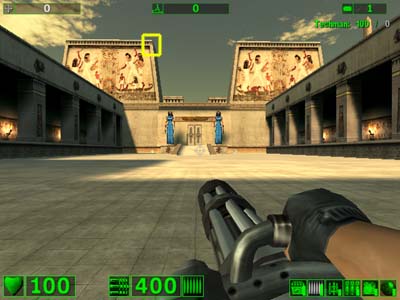ATI's SMOOTHVISION - The key to its "success"
by Anand Lal Shimpi on November 26, 2001 5:29 AM EST- Posted in
- GPUs
Answer 2: "Performance" mode uses fewer samples
There were two issues of quality that we brought up with ATI in regards to their latest driver release. The first was a question as to why the sky in Quake III Arena looked so blotchy compared to what it should look like. We had assumed it was because ATI was auto-compressing textures and unfortunately ATI couldn't get us an answer in time for this article. The second question was in regards to the actual edge AA quality of SMOOTHVISION's "performance" mode.
To quote our previous article, "However, you can also clearly see that NVIDIA's 4X solution is better at reducing the infamous "jaggies" than ATI's 4X performance solution."
We went to ATI asking exactly why this was and the answer we received indicated that it was a difference in the sampling or filtering used by the "performance" AA mode. ATI was obviously reluctant to give out too much information about what the true differences between the "performance" and "quality" AA modes in order to protect their technology from competitors. Truthfully however it is pretty easy to find out much more information about a particular AA mode given the right type of screen.
Take this screen shot from Serious Sam for example:

We zoomed in on the area enclosed by the yellow box and here's what we found (Note: since these screenshots are so small we'd suggest setting your screen resolution to no greater than 1024 x 768):
|
ATI
Radeon 8500
AA Off  |
ATI
Radeon 8500
2X Performance AA  |
ATI
Radeon 8500
2X Quality AA  |
You can clearly count the number of steps along the right side of the structure and in theory, the number of steps should increase as you take more AA samples. Now notice the difference between the screenshot with AA turned off and ATI's 2X performance mode; that's right, there is none. Look at the edge in the 2X Quality AA shot, see how smooth it is?
Could it be that ATI is not actually enabling AA in their performance mode? That wouldn't make much sense since we did see some evidence of AA in the previous review. Let's dig a little deeper.
|
ATI
Radeon 8500
AA Off  |
ATI
Radeon 8500
4X Performance AA 
|
ATI
Radeon 8500
4X Quality AA 
|
In the 4X AA mode the difference is much less pronounced, it still appears as if there is a difference in the number of samples between the Performance and Quality AA modes although both are supposed to be "4X" modes.
|
ATI
Radeon 8500
AA Off  |
ATI
Radeon 8500
2X Performance AA  |
ATI
Radeon 8500
2X Quality AA  |
The above shots are taken from the same exact scene, but now looking along an edge perpendicular to the original edge we were examining. Here you can see that in the 2X performance AA shot there are approximately twice as many steps along the bottom of the wall as in the original shot with AA turned off. The only difference between the performance AA and quality AA modes here is that the quality AA mode looks better, but it's clear both modes are anti-aliased.
|
ATI
Radeon 8500
AA Off  |
ATI
Radeon 8500
4X Performance AA  |
ATI
Radeon 8500
4X Quality AA  |
In 4X mode there is absolutely no difference between the Performance and Quality AA modes in terms of edge anti-aliasing here.
What does this prove? The only conclusion we can come to is that in the performance mode there are fewer samples being taken than in the quality mode meaning that 2X "performance" and 2X "quality" (the same applies to both 4X modes) aren't both 2X sampling modes.










0 Comments
View All Comments